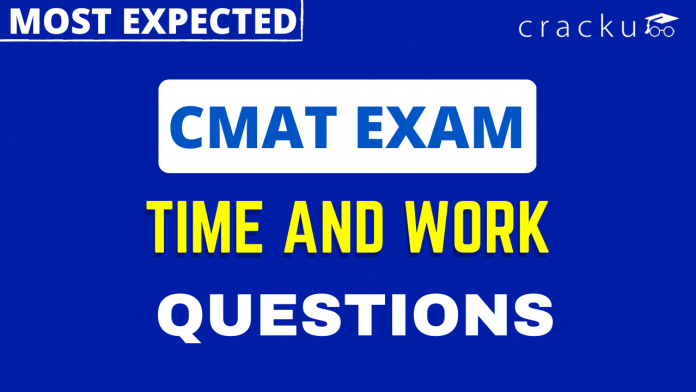CMAT Time and Work Questions [Download PDF]
Download CMAT Time and Work questions with solutions PDF by Cracku. Practice CMAT solved Time and Work Questions paper tests, which are the practice question to have a firm grasp on the Time and Work topic in the CMAT exam. Top 10 very Important Time and Work Questions for CMAT based on the questions asked in previous exam papers. Click on the link below to download the Time and Work Questions for CMAT PDF with detailed solutions.
Download Time and Work Questions for CMAT
Enroll to CMAT 2023 Crash Course
Question 1: A boat takes 2 hours to travel from point A to B in still water .To find out it’s speed up-stream ,which of the following information is needed.
i. Distance between point A and B
Ii.Time taken to travel down stream from B to A
iii. Speed of the stream of the water
iv. Effective speed of Boat while traveling Downstream from B to A
a) All are required
b) Even these we cannot found the answer
c) Only i,iii, and either ii or iv
d) Only i and iii
e) None of these
1) Answer (D)
Solution:
Time taken by boat to travel from point A to B in still water = 2 hours
To find the upstream speed, we definitely need the speed of stream, thus statement (iii) is mandatory.
Also, the distance between points A and B or the speed of boat in still water is needed.
Thus, statements (i) and (iii) are required to find the upstream speed of the boat.
=> Ans – (D)
Question 2: A man takes 2.2 times as long to row a distance upstream as to row the same distance downstream. If he can row 55 km downstream in 2 hours 30 minutes, what is the speed of the boat in still water? (in km/h)
a) 40
b) 8
c) 16
d) 24
e) 32
2) Answer (C)
Solution:
Let speed of boat in still water = $x$ km/hr
=> Speed of current = $y$ km/hr
Let distance travelled = $d$ km
Acc. to ques, => $2.2 (\frac{d}{x + y}) = \frac{d}{x – y}$
=> $2.2x – 2.2y = x + y$
=> $2.2x – x = y + 2.2y$
=> $3x = 8y$ ————-(i)
Also, the man takes 2 hrs 30 mins in travelling 55 km downstream.
=> $\frac{55}{x + y} = 2 + \frac{1}{2}$
=> $\frac{55}{x + y} = \frac{5}{2}$
=> $x + y = 22$
Multiplying both sides by 8, and using eqn(i), we get :
=> $8x + 3x = 22 \times 8$
=> $x = \frac{22 \times 8}{11} = 16$ km/hr
Question 3: A boat takes a total time of twelve hours to travel 105 kms upstream and the same distance downstream. The speed of the boat in still water is six times of the speed of the current. What is the speed of the boat in still water? (in km/hr)
a) 12
b) 30
c) 18
d) 24
e) 36
3) Answer (C)
Solution:
Let speed of current = $x$ km/hr
=> Speed of boat in still water = $6x$ km/hr
Acc. to ques, => $\frac{105}{7x} + \frac{105}{5x} = 12$
=> $\frac{15}{x} + \frac{21}{x} = 12$
=> $\frac{36}{x} = 12$
=> $x = \frac{36}{12} = 3$
$\therefore$ Speed of boat in still water = $6 \times 3 = 18$ km/hr
Question 4: A car runs at the speed of 50 kms per hour when not serviced and runs at 60 km./hr. when serviced. After servicing the car covers a certain distance in 6 hours. How much time will the car take to cover the same distance when not serviced?
a) 8.2 hours
b) 6.5 hours
c) 8 hours
d) 7.2 hours
e) None of these
4) Answer (D)
Solution:
After servicing, the distance covered by car in 6 hours = 60 * 6 = 360 km
Without servicing, speed of car = 50 kmph
=> Required time = $\frac{Distance}{Speed}$
= $\frac{360}{50}$ = 7.2 hr
Question 5: A man and a woman, working together can do a work in 66 days. The ratio of their working efficiencies is 3 : 2. In how many days 6 men and 2 women working together can do the same work?
a) 18
b) 15
c) 14
d) 12
5) Answer (B)
Solution:
Let the total work be 330 units.
Efficiency of a man and a woman together = $\frac{330}{66}$ = 5 units/day
The ratio of the working efficiencies of man and woman is 3 : 2.
Efficiency of a man = 3 units/day
Efficiency of a woman = 2 units/day
Efficiency of 6 men and 2 women together = (6 x 3) + (2 x 2) = 22 units/day
Time required for 6 men and 2 women together to complete the work = $\frac{330}{22}$ = 15 days
Hence, the correct answer is Option B
Question 6: A train running at $40\frac{1}{2}$ km/h takes 24 seconds to cross a pole. How much time (in seconds) will it take to pass a 450 m long bridge?
a) 56
b) 52
c) 60
d) 64
6) Answer (D)
Solution:
Let the length of the train = L
Speed of the train = $40\frac{1}{2}$ km/h = $\frac{81}{2}$ km/h = $\frac{81}{2}\times\frac{5}{18}$ m/sec = $\frac{45}{4}$ m/sec
Train crosses a pole in 24 seconds.
$\frac{L}{\frac{45}{4}}$ = 24
$\frac{4L}{45}$ = 24
L = 270 m
Length of the train = L = 270 m
Time required for train to pass a 450 m long bridge = $\frac{L+450}{\frac{45}{4}}$
= $\frac{270+450}{\frac{45}{4}}$
= $\frac{720\times4}{45}$
= 64 sec
Hence, the correct answer is Option D
Question 7: A and B can do certain work in 18 days and 30 days,respectively. They work together for 5 days. C alone completes the remaining work in 15 days. A and C together can complete $\frac{5}{6}$th part of the same work in:
a) 6 days
b) 8 days
c) 9 days
d) 5 days
7) Answer (C)
Solution:
Let the total work = 360 units
Efficiency of A = $\frac{360}{18}$ = 20 units/day
Efficiency of B = $\frac{360}{30}$ = 12 units/day
A and B worked together for 5 days.
Work done by A and B together in 5 days = 5 x (20 + 12) = 160 units
Remaining work = 360 – 160 = 200 units
C alone completes the remaining work in 15 days.
Efficiency of C = $\frac{200}{15}$ = $\frac{40}{3}$ units/day
Efficiency of A and C together = 20 + $\frac{40}{3}$ = $\frac{100}{3}$ units/day
$\frac{5}{6}$th of the total work = $\frac{5}{6}\times$360 = 300 units
Number of days required for A and C together to complete $\frac{5}{6}$th of work = $\frac{300}{\frac{100}{3}}$
= $\frac{300\times3}{100}$
= 9 days
Hence, the correct answer is Option C
Question 8: A can complete a work in $11\frac{1}{2}$ days. B is 25% more efficient than A and C is 50% less efficient than B. Working together A, B and C will complete the same work
a) 5 days
b) 4 days
c) 3 days
d) 8 days
8) Answer (B)
Solution:
Let the total work = 460 units
A can complete a work in $11\frac{1}{2}$ days.
Efficiency of A = $\frac{460}{\frac{23}{2}}$ = 40 units/day
B is 25% more efficient than A.
Efficiency of B = $\frac{125}{100}\times40$ = 50 units/day
C is 50% less efficient than B.
Efficiency of C = $\frac{50}{100}\times50$ = 25 units/day
Efficiency of A, B and C together = 40 + 50 + 25 = 115 units/day
Number of days required for A, B and C together to complete the work = $\frac{460}{115}$ = 4 days
Hence, the correct answer is Option B
Question 9: A train covers 450 km at a uniform speed. If the speed had been 5 km/h more, it would have taken 1 hour less to cover the same distance. How much time will it take to cover 315 km at its usual speed?
a) 7h 52m
b) 6h 30m
c) 6h 18m
d) 7h
9) Answer (D)
Solution:
Let the uniform speed of train = s
According to the problem,
$\frac{450}{s+5}=\frac{450}{s}-1$
$\frac{450}{s}-\frac{450}{s+5}=1$
$450\left(\frac{s+5-s}{s\left(s+5\right)}\right)=1$
$450\left(\frac{5}{s^2+5s}\right)=1$
$s^2+5s-2250=0$
$\left(s+50\right)\left(s-45\right)=0$
s = -50 or s = 45
s cannot be negative, so s = 45 km/h
The uniform speed of train = 45 km/h
Time taken by train to cover 315 km at its usual speed = $\frac{315}{45}$ = 7 hours
Hence, the correct answer is Option D
Question 10: To do a certain work, efficiencies of A and B are in the ratio 7:5. Working together, they can complete the work in $17\frac{1}{2}$ days. In how many days, will B alone complete 50% of the same work?
a) 42
b) 21
c) 15
d) 30
10) Answer (B)
Solution:
Let the total work = 700 units
Efficiencies of A and B are in the ratio 7:5.
Let the efficiency of A and B are 7p and 5p respectively.
Efficiencies of A and B together = 7p + 5p = 12p units/day
Working together, they can complete the work in $17\frac{1}{2}$ days.
$\frac{700}{12p}$ = $17\frac{1}{2}$
$\frac{700}{12p}$ = $\frac{35}{2}$
p = $\frac{10}{3}$
Efficiency of B = 5p = $\frac{50}{3}$ units/day
Number of days required for B alone complete 50% of the same work = $\frac{350}{\frac{50}{3}}$
= $\frac{350\times3}{50}$
= 21 days
Hence, the correct answer is Option B





